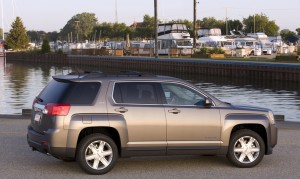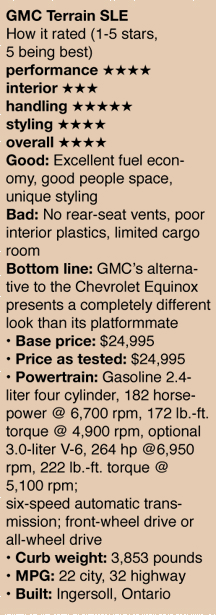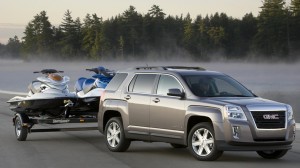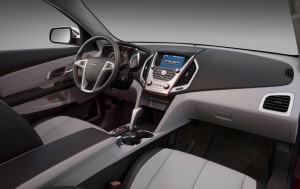
GMC's Terrain is built on the same platform as the Chevrolet Equinox, but unique sheetmetal gives it a completely different look.
There was a time when it seemed General Motors was content to slap a different grille on the front and a different sticker on the back and sell the same car under three or four different brands. A Chevrolet Uplander minivan was the same as a Pontiac Montana, not to mention the Buick Terraza and Saturn Relay.
In fact, this GMC Terrain illustrates how GM is now going about what many have derisively called “badge engineering.” The Terrain is a twin of the new Chevrolet Equinox, but you’d hardly notice based on the sheetmetal.
Where the Equinox has a sleek look, the GMC version is blocky and angular. It’s safe to say that those who find the Equinox appealing probably won’t care for the Equinox and vice versa.
In reality, the two vehicles’ hardpoints, such as the wheelbase, windshield and door openings are all the same.
 This is a far cry from the previous Equinox, whose former twin, the Pontiac Torrent, was all but indistinguishable from the Chevy. What was the point? If you’re going to sell two vehicles that are indistinguishable, wouldn’t it be better to sell just one and eliminate the duplication of marketing and other efforts?
This is a far cry from the previous Equinox, whose former twin, the Pontiac Torrent, was all but indistinguishable from the Chevy. What was the point? If you’re going to sell two vehicles that are indistinguishable, wouldn’t it be better to sell just one and eliminate the duplication of marketing and other efforts?
The point should be to provide different looks for different tastes. It’s more expensive to make two different sets of body panels, but without them, it would make sense to just sell one version.
One older gentleman at a garage sale in Oscoda, Mich., said he finds the Terrain better looking than the Equinox. He was interested in its ride and the interior. Overall, the Equinox seemed to get the better reaction from onlookers.
Underneath the unique body panels, the Terrain and Equinox are essentially the same vehicle. Like the Equinox, the Terrain comes standard with a 2.4-liter, 182-horsepower four cylinder with direct injection. A direct-injected 264-horsepower 3.0-liter V-6 is optional. Both engines are backed by a slick-shifting 6-speed automatic transmission. Front-wheel drive is standard, but all-wheel drive is a $1,750 option available with either engine.
The test vehicle was a base SLE with four cylinder engine and front-wheel drive. With destination, Terrains start at $24,995. With no options, that was also the final price.
That price includes a surprising level of standard equipment. Heated outside mirrors, backup camera (showing an image on the rear-view mirror), USB and auxiliary jack for connecting mp3 players and aluminum wheels are all standard on the Terrain. If you’re interested in a less-expensive version, visit the Chevy store and look at the Equinox.
The Terrain handles very well, with absolutely no torque steer. The ride is easy, yet the trucklet handles curves as well as can be expected of one of these tall wagons.
The four cylinder engine is generally smooth and quiet, at least until you ask for maximum acceleration, which is fairly often because it’s clear that the GM made every effort to squeeze the best mileage possible out of the little engine. On that front, it did very well. With EPA mileage numbers of 22 city and 32 highway, the Terrain (as well as the Equinox) is the most fuel-efficient non-hybrid small SUV on the market. In fact, it’s highway number is actually better than that of the Ford Escape Hybrid’s (31).
Possibly one of the most important deciding factors for people choosing between the two engines will be towing capacity. Four-cylinder Terrains can tow 1,500 pounds, but V-6 versions can tow up to 3,500 pounds, which is the norm for small crossovers and minivans.
The Terrain’s interior is spacious, particularly for passengers. Those in the front seats have plenty of room and will find lots of space to stash travel detritus such as cellphones and sunglasses cases. The extremely deep center console will swallow anything your biggest purse can dish out. Careful though, you could lose a Yorkie in there.
Much of the Terrain’s plastics look fairly good, but are stiff to the touch. There are some poor partlines and a few rough edges. The plastic steering wheel feels rough.

The GMC Terrain can tow up to 1,500 pounds with the base 2.4-liter four cylinder or 3,500 pounds with the optional 3.0-liter V6.
The rear seat slides to maximize rear seat space or cargo space. Speaking of cargo room, the space behind the rear seats seems somewhat limited compared to the Terrain’s competitors. Still, there is more than 31 cubic feet behind the rear seats, almost 64 cubes with rear seats folded.
GM would do well to add some vents for rear-seat passengers. As it is now, those in back will likely ask those in front to freeze or heat themselves out to get some fresh air.
Is it worth the cost and effort for an automaker to give similar vehicles sold under different brands unique styling treatments? The better question is why would an automaker market separate vehicles if it’s only going to change the grilles and the stickers on the back end. Give the vehicles unique styling and there’s at least a reason to offer different versions of the same vehicle.

